The International Maritime Organization (IMO) pays especial attention to human factors in maritime safety and environmental protection. The study results indicate that more than 80% of maritime accidents are caused by human factors, of which the human fatigue factor accounts for a large proportion[1]. Since working and leisure time is spent in the same restricted environment for a lengthy period, navigation is an innately stressful environment[2]. The unpredictable and demanding working conditions foster a high potential for risks and accidents[3]. According to the interviews with seafarers, managers from Canadian shipping companies, union representatives and the government, fatigue is the most commonly identified safety challenge[4]. Seafarers must have a “can do” attitude to combat fatigue, whereas the crew must have a creed, namely “pride and adrenaline overpower fatigue…plus coffee and Red Bull.” Both can be a good initiative, but are accompanied by poor judgment when trying to work hard[5]. As the IMO guidance pointed out that fatigue is the biggest hidden risk of major accidents[6], and the increasing operation costs caused by human fatigue are also significant. Fatigue generally refers to a phenomenon that people lose their efficiency and concentration after continuous study or work. Meanwhile, it can also be regarded as a subjective feeling of discomfort, so that operational capabilities are reduced if the crew continue to engage in activities or work[7]. Human fatigue is a dangerous behavior where the sufferer cannot obtain or deal with the necessary information in time due to the decline of psychological or physiological function[7-8]. Therefore, human fatigue is an dangerous factor in ship navigation, and has become an important issue of maritime transportation safety to reduce the number of fatigue accidents and improve the capacity of ship navigation safety.
On the one hand, fatigue is regarded as an issue related to physiology and psychology, or as a safety issue in transportation systems. According to the related literature, including guidance and the handbooks, there are many factors that can cause crew fatigue, such as a lack of sleep, stress, and the environment. By using the analytic hierarchy process (AHP) and lactic acid test, Bal et al. [1] analyzed the factors affecting seafarers’ fatigue and determined their quantitative priorities. Besides, several crew fatigue factors such as sleep conditions, biological clocks, stress, work load, and personal factors are involved. “Guidance on Fatigue Mitigation and Management”[6] clearly listed the factors leading to crew fatigue, mainly sleep quality, sleep quantity, sleep duration, sleep disorders/disturbances, rest breaks, biological clock/circadian rhythms, fear, monotony and boredom, diet, illness, stress from skills and knowledge and training, personal problems, interpersonal relationships, alcohol, drugs (prescription and non-prescription), caffeine, age, shiftwork and work schedules, workload (mental/physical), and jet lag. Smith et al. [7] mentioned fatigue risk factors such as circadian rhythms, working patterns, shift schedules, noise, motion, sleep, age, the working time of the day, and health. Allen et al.[8] reviewed maritime fatigue literature, and summarized fatigue risk factors, such as circadian rhythms, working patterns and shift schedules, noise and motion, sleep, environmental and organizational factors. Rhodes et al.[9] wrote a handbook about fatigue management, which included the nature and function of sleep, biological rhythms, the sleep/wake cycle, rhythm of sleepiness, and irregular work schedules. van Leeuwen et al. [10] studied a sleep issue and the corresponding maritime watch system, where sleep factors and work factors were involved, especially work patterns. Strauch[11] suggested that sleep is closely associated with fatigue, which includes interrupted sleep and circadian sleep rhythms. Besides, obstructive sleep apnea, prescription and non-prescription medications, and an extended waking time can also cause fatigue. Ship collision and grounding accidents can be caused by fatigue factors, including shift work, irregular working hours, inadequate task allocations, and excessive demands[12]. Bal Be
![]() et al. [13] applied the method of subjective measurement to study the seafarers’ fatigue, which mentioned environmental factors (weather), work areas and recreational areas, types of ships, the model and the length of navigation, the time to return to the harbor and the time that the ship remains in port, shift system (shift-work), incomplete sleep cycle, biological clocks, jet lag, intensive paperwork, noise and motion. According to the occupational safety and health status of service crew working on Swedish passenger ships, significant factors in the ship’s working environment include high physical loads and strenuous working postures, poor workplace design, a long working time, limited recovery time, unclear boundaries between work and entertainment, and social interaction with customers and colleagues[14]. Riethmeister et al.[15] suggested that prolonging offshore periods probably lead to raised fatigue risk.
et al. [13] applied the method of subjective measurement to study the seafarers’ fatigue, which mentioned environmental factors (weather), work areas and recreational areas, types of ships, the model and the length of navigation, the time to return to the harbor and the time that the ship remains in port, shift system (shift-work), incomplete sleep cycle, biological clocks, jet lag, intensive paperwork, noise and motion. According to the occupational safety and health status of service crew working on Swedish passenger ships, significant factors in the ship’s working environment include high physical loads and strenuous working postures, poor workplace design, a long working time, limited recovery time, unclear boundaries between work and entertainment, and social interaction with customers and colleagues[14]. Riethmeister et al.[15] suggested that prolonging offshore periods probably lead to raised fatigue risk.
On the other hand, scenario analysis can effectively process factors with uncertainty, such as decision making and strategy planning, which are widely used in society and political domains. Raele et al.[16] established scenarios for the ethanol industry in Brazil, by using scenario construction methods and concepts of stakeholder analysis. In that study, four scenarios were constructed, which can be used in the development of public policy and as a tool for decision making, and provide an orderly construction of scenarios for future studies. Scenario development plays a significant role in strategic planning, as the process supports the development of the vision for the future and the actions required to achieve their realization[17]. Scenarios can support strategic decision making, especially effective in processing uncertainties[18]. When the future is considered to be surrounded by high uncertainty and complexity, scenario analysis can be a tool of strategic planning. This method, characterized by the synthesis of quantitative and qualitative information, can construct multiple scenarios or alternative portraits of the future[19]. Scenario discovery is a model-based technique, which can support dealing with uncertainty in many policy fields[20]. Scenarios can serve as a reference in future decision making, and morphological analysis provides a structured method for ensuring consistency and relevance in scenario development[21]. This paper introduces a method to generate, analyze and optimize complex industrial operation scenarios by morphological analysis, the first stage of which completes the information acquisition and representation[22]. Morphological analysis allows any number of dimensions to be retained when constructing future conditions[23].
According to the literature review, it can be found that fatigue factors and their relationships have been partially studied. In fact, the formation of fatigue can be regarded as a process caused by various factors, some of which can be interactional. Thus, it is valuable to consider all human fatigue factors in a single system, and to illustrate their interaction. If the formation of human fatigue is regarded as a system, it should be composed of numerous variables and connections, with uncertainty and complexity. A complex problem even with a good nature possibly involves a number of parameters and may produce a remarkable number of possible scenarios. Applying the morphological methodology to a process can be an effective method to classify the involved variables with a basic logical perspective. Therefore, scenario analysis can be an effective tool for constructing a system with numerous variables. In this study, the method of using morphological analysis, quantitative scale and a matrix is proposed to analyze the variables with classification, correlation and construction. The reason for choosing this method is that even though the causes of fatigue can be classified into several categories, it is not enough to explain the issue because some of the causes can influence others. The simple classification cannot illustrate the interaction between factors. Therefore, it is essential to consider the internal logic of the entire system. This paper aims to analyze the fatigue factors taken as variables and to construct a possible scenario. Four types of scenarios are proposed, one of which is illustrated as a representative case to indicate the relationship of fatigue causes.
1 Methodology
Considering the characteristics of fatigue, the quantitative analysis and qualitative analysis are both included in this study. Therefore, morphological analysis, quantitative scales and matrices are combined to study the fatigue causes and their relationship. In particular, several steps will be adjusted to fit this research. The steps of the scenario development are presented in Fig.1.

Fig.1 Steps of the scenario development
1.1 Defining the scope
The first step in developing scenarios is to define the scope of the study, which contains the choice of study object and related factors. Obviously, the scope in this study involves fatigue causes, which are regarded as variables. In addition, their relationship is also included in the study.
1.2 Preliminary evaluation of variables
The second step is a generation of environmental variables and evaluating their relationship. Firstly, the primary stage is extracting all related variables because some variables may be cited with different nomenclatures. Thus, it is essential to unify and explain the variables found in different literature[16]. In addition, each variable needs to be categorized. Finally, the variable pairs are qualitatively assessed by morphological analysis, which will be introduced specifically as follows. The construction of scenarios aims to transform the multifaceted and uncertain problem into a limited type of particular scenarios. To understand the research subject, it is initial to propose some techniques or methods[17-20]. Although it can be impossible to perfectly eliminate the gap between scenario models and the reality, general morphological analysis can be a foundation of scenario modeling to organize the elements and their relationship[21].
There are five steps to complete with a morphological box[21]. The first step is constructing the problem as clearly as possible, although an absolute accurate description of the problem is hardly possible. For the second step, the problem must be solved as a set of parameters to construct the problem. Each parameter must be accurately defined and a set of possible conditions or values associated with each parameter must be determined. The third step contains the construction of morphological frames or multidimensional matrices including all possible circumstances related to the problem. This condition indicates the shape or configuration of a value for each parameter. The box itself contains the entire morphological domain (or problem space) of a given problem. The problem space covers all the circumstances that can be constructed from a set of parameters. In addition, problem spaces usually contain a large number of “chain reactions” in the form of correlative circumstances. The fourth step is to make a thorough analysis of the whole morphological field in order to find out the quantity of the correlation and to outline the relationship between various factors. At this stage, the correlation is based on two criteria, logical consistency and empirical consistency, which means that the relationship of the variable pairs cannot be logically contradictory or violate common sense. For the fifth step, the best solution from the remaining solution space should be selected. While this step is omitted in this study, and further study is based on the previous steps, which will be presented as follows.
1.3 Importance and uncertainty of variables
The third step is to qualify the variables in the classifications of importance and uncertainty. The variables qualification in this step and next step are based on quantitative scales and matrices, through a structured questionnaire to crews, by a unified scale. The scale is based on the Stapel scale, which is a unipolar scale, ranging from -5 to +5, measuring the direction and intensity in the meantime[16]. In other words, these scales are related to the variable importance, ranging from very low (-5) to very high (+5), and the degree of uncertainty is according to the scale from “is a trend” (-5) to “is an uncertainty” (+5)[16]. However, in this paper, the scale range is changed to 0 to 5 due to the following reasons. Firstly, the importance is related to the impact degree of variables, while all the variables in this paper are related to fatigue. It is meaningless to consider those variables as negative numbers. Secondly, considering the potential case that the meaning of “uncertainty” is ambiguous for some candidates, the quantification of uncertainty depends on two aspects: frequency and volatility. The extremely high or low frequency indicates lower uncertainty and high volatility indicates higher uncertainty. Thus, the score of uncertainty can be calculated as
(1)
where Xf presents the average point of frequency and Xv presents the average point of volatility.
Scenario planning simulates any circumstances involving uncertainties and ambiguities[16]. Therefore, the initial attraction for the development of scenarios is that the scenario modeling enables the systematic consideration of critical uncertainties for the study subject[24]. Considering the basic variables for constructing scenarios, the relationships between the trends and uncertainties, in turn, show a group of different scenarios. Trends are environmental variables with a comparatively high degree of probability that influence the whole system[25]. Uncertainties concern variables where, although they are known, their degree of probability is unknown or difficult to estimate[16]. The classification of the property of the variable, which includes importance and uncertainty, is essential for selecting variables that generate scenarios because variables classified as uncertainties form the main axis of scenario construction. Classification and identification of variables using the importance and uncertainty matrix are proposed by Mitroff and Emshoff[26]. Trends and uncertainties affecting other variables in the system are called key variables[27], as described below.
1.4 Variables
The fourth step describes the key variables from two aspects: One is the influence degree of variables on the cause of fatigue, and the other is the degree of dependence between variables. These variables need to be quantified by pairing scale comparisons. Alreck and Settle[28] highlighted that this scale is suitable for reviewing the evaluation of one entity relative to another, in other words, only two variables are classified at a time. In this respect, each pair of variables will be evaluated. Hence, it is necessary to construct the matrix of variable pairs.

(2)
where aij represents the relationship between variable i and variable j. More specifically, the points for variable influence are based on all possible combinations of variable pairs[27]. For each pair of variables (aij), the degree of variable i influencing variable j, are set from 0 to 1, which means from no impact to total impact.
Thus,the influence point of a variable is the sum of each influence degree. It can be expressed as
(3)
when i=j, aij=0, which means that any variable cannot influence itself. In this study, there are 15 variables. The maximum score of a variable is (n-1), or 14 points.
Correspondingly,in the case of the dependence analysis, the influence can be considered as dependence by another perspective. In other words, the dependence points are the sum of each variable pair by vertical instead of horizontal, which can be expressed as
(4)
when i=j, aij=0. In addition, the influence and dependence scores of each variable are then normalized to 100.
This is done by matching the average of the impact points with the median of 50, which can be considered as a standard 100-point scale. Therefore, variable values are assigned on a scale of 100 points between the axis of influence and dependence, thus forming the structure of the influence and dependence matrices. Based on the normalized values of the variables, the points of influence and dependence are plotted in a matrix. According to Godet[27], the matrix can be divided into five areas. In this study, five sectors are defined as shown in Fig.2, and the boundaries are 40 to 60. Based on the normalized values of the variables, the influence points and dependence points are drawn in the matrix. The matrix can be divided into five regions[27], which are defined in Tab.1. The final phase of this step, including the key variables choice, is completed by examining Fig.2. Particularly, the goal is to find variables such as uncertainties so that the axis of the scenarios can be generated. More specifically, the key variables fall in sector 1, because they are the domi-nant variables in the system[25]. If the first sector does not have enough variables in category uncertainty, ones with higher influence and lower dependence should be sought in sector 5.
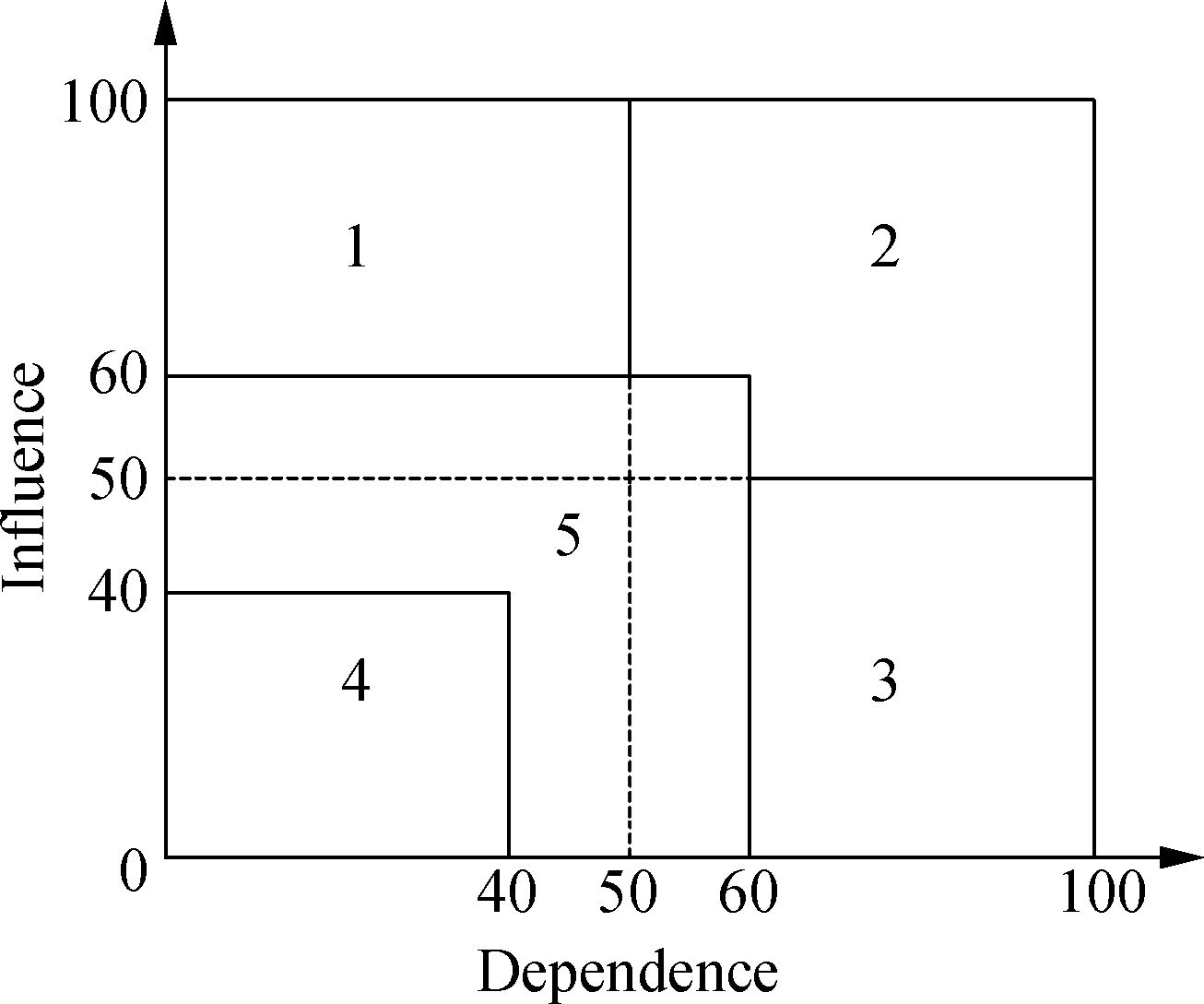
Fig.2 Graph of variable influence and dependence
Tab.1 Sectors and their descriptions
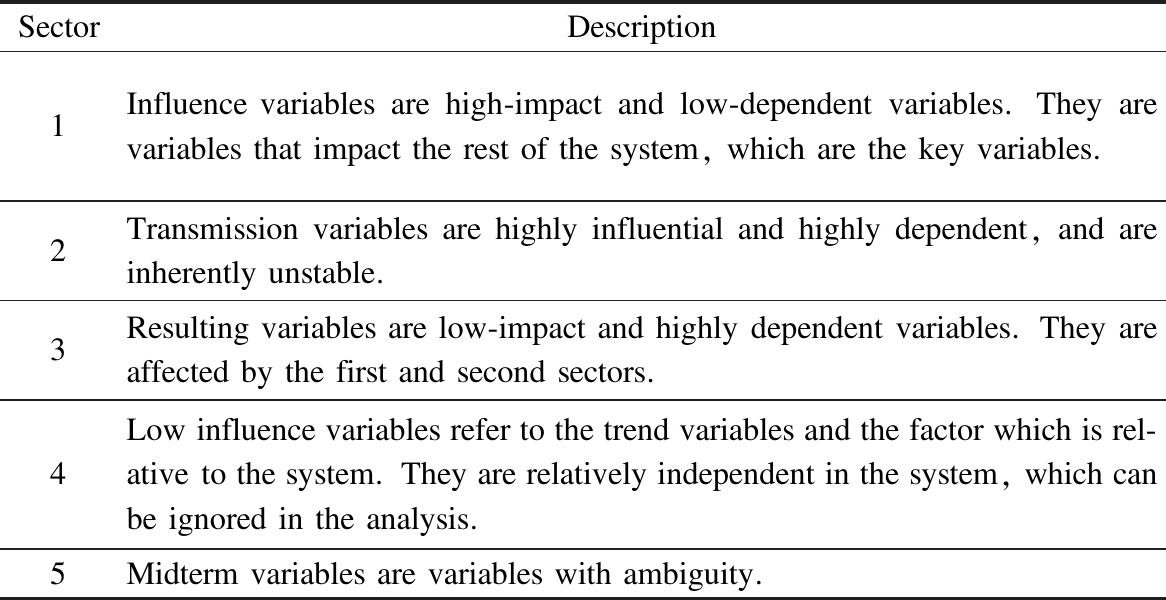
SectorDescription1Influence variables are high-impact and low-dependent variables. They are variables that impact the rest of the system, which are the key variables.2Transmission variables are highly influential and highly dependent, and are inherently unstable.3Resulting variables are low-impact and highly dependent variables. They are affected by the first and second sectors.4Low influence variables refer to the trend variables and the factor which is rel-ative to the system. They are relatively independent in the system, which can be ignored in the analysis.5Midterm variables are variables with ambiguity.
1.5 Scenario generation
In this study, several potential circumstances of crew’s fatigue are considered as scenarios, and the causes of fatigue are considered as variables. The classified variables and their relationship are evaluated, and the qualification of their trends or uncertainty and their influence or dependence have been assessed. Moreover, it also illustrates a consecution of how trends and uncertainties link to each other. After analyzing the interaction between the obtained variables and their properties, a diagram is constructed.
2 Scenario Analysis of Human Fatigue
2.1 Defining the scope
In this study, the study scope is human fatigue factors in the maritime transportation system. This analysis is based on the variables affected by fatigue. The research regards fatigue variables as the starting point of the analysis to establish the framework of the fatigue factors.The next step is how to define variables from numerous fatigue factors.
2.2 Preliminary evaluation of variables
Due to various fatigue factors and complex relationships among them, it is necessary to identify key fatigue factors and analyze their relationship. The description of variables and relationship between fatigue factors is mainly obtained through previous research and official publications, especially via the IMO guidance. In the introduction, several fatigue related studies have been illustrated, and numerous fatigue factors have been included. Obviously, some of them are the same or similar, thus, it is essential to unify the factor descriptions (some factors may be referred to different nomenclatures but have similar meanings). Additionally, it is necessary to understand the inclusion relation of each fatigue factor, in order to reduce the number of variables.
According to literature review in the introduction, there are 73 factors initially. After preliminary screening and excluding the same nomenclatures, there are 47 factors left. Considering the similar meaning of those factors and their relationship, and the basic concepts in understanding fatigue involving sleep, biological clock and circadian rhythm, and stress, the factors need to be further processed. The description and relationship of each variable are given in the literature, which can be the evidence of the variable qualification. Thus, 15 variables are classfied into several aspects including sleep issues, stress, personal conditions, work-related factors and the environment. These variables are closely related to crew fatigue, which can be divided into four categories (see Tab.2).
Tab.2 Categories of fatigue factors

CategoryNumberFatigue factorsSleep,rest andrhythms1Lack of sleep2Poor quality of sleep3Insufficient rest time between work periods4Poor quality of rest5Biological clock/circadian rhythms/jet lagWorkfactors6Boring and repetitive work7Excessive workload8Shiftwork and work schedulesPersonalcondition9Psychological, emotional factors and stress10Diet(timing, frequency, content and quality)11Medical conditions and illnesses12Ingested chemicalsEnvironmentfactors13Noise or vibration14Ship movement15Temperature and humidity
In this study, scenario modeling with morphological analysis is applied to classify fatigue factors. In addition, the factors are not mutually independent because some of them can influence others. As a result, the correlation of factors needs to be analyzed. In the following study, the fatigue factors will be analyzed as variables, in order to construct the scenarios. Tab.3 demonstrates the correlation of each variable pair, but the variables in the same category are not considered due to the interaction. The next section will show the further analysis of the variables.
Tab.3 Correlation matrix of variables

Variablenumber1234567891011121314151NNNNNNNNNNNNNNN2NNNNNNNNNNNNNNN3NNNNNNNNNNNNNNN4NNNNNNNNNNNNNNN5NNNNNNNNNNNNNNN6RRRRWNNNNNNNNNN7RRWWWNNNNNNNNNN8RRWWWNNNNNNNNNN9RRWRRNNNNNNNNNN10WWRWWRWWWNNNNNN11RRRRRRWWRNNNNNN12RRRWRWWWRNNNNNN13RRWRWRWWWWWWNNN14WRWRWRWWWWWWNNN15WRWRWRWWWWWWNNN
Notes: R indicates a remarkable correlation variable pair. W indicates that the relevant variable pairs are assessed to have no or a weaker relationship. N indicates that the relevant variable pairs are not considered in the corresponding section.
2.3 Importance and uncertainty of variables
For this step and next step, the questionnaire survey is used. 109 crew members participated in this survey, and 102 samples can be used in the following research. The questionnaire is structural and divided into 2 parts: Part 1 will be used in this section, and part 2 will be used in the next section. As Section 1.3 mentioned, according to the quantitative scales questionnaire, considering the qualification of importance, the uncertainty of variables can be calculated by Eq.(1). Tab.4 lists the 15 variables which are considered to be most important relating to the average, and classified into trends or uncertainties. In addition, the justification for why the variables are classified as a trend is that even though their exact state is unknown, their circumstances are relatively stable when the ship is sailing[2-9].
2.4 Key variables
When the importance and uncertainty of variables are established, the following step is to further evaluate the variables’ relationship in the system. Similar to Section 2.2, the variables are combined in pairs for further evaluation, and the values of variable pairs are based on a structured questionnaire. Tab.5 shows the evaluation of each variable pair, and the methodology can be found in Section 1.4 (see Tab.1). Considering that some of the variable pairs have been assessed in Section 2.2, the rest of pairs need to be included in a structured questionnaire.
According to Eqs.(3) and (4), the influence and dependence of each variable can be calculated as shown in Tab.6. The absolute averages and normalized variables are ranked first by sectors and secondly by order of influ-ence. Fig.3 displays the matrix of influence and dependence of the specific variables, which has been shown in Fig.2. The boundary of each sector is highlighted by the dotted line[16].
Tab.4 Variables’ importance and uncertainty

Variable number123456789101112131415Importance4.84.84.34.24.94.73.53.23.33.94.12.23.63.81.7Importance degreeUncertainty4.74.84.44.54.13.80.44.23.91.72.90.30.52.31.8Uncertainty degree
Note: “√” indicates that the variables are the candidates of key variables.
Tab.5 The matrix of variable pairs evaluation
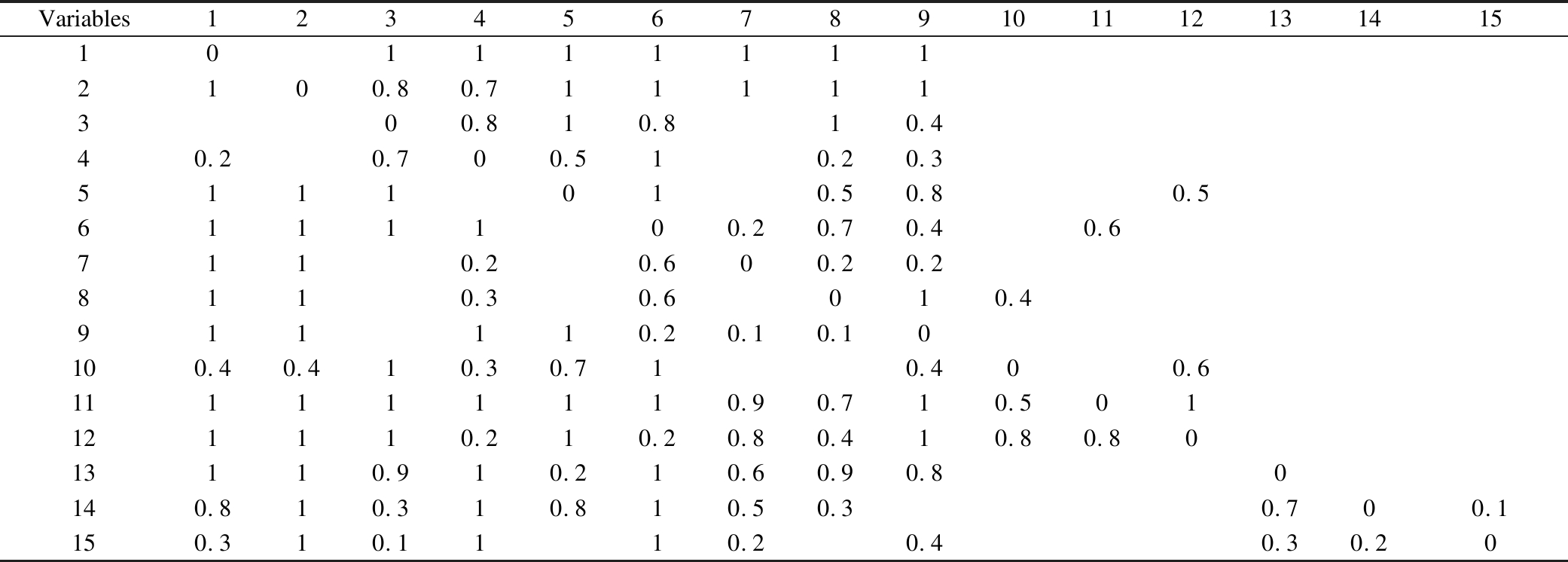
Variables1234567891011121314151011111112100.80.711111300.810.810.440.20.700.510.20.35111010.50.80.56111100.20.70.40.67110.20.600.20.28110.30.6010.4911110.20.10.10100.40.410.30.710.400.6111111110.90.710.501121110.210.20.80.410.80.8013110.910.210.60.90.80140.810.310.810.50.30.700.1150.310.1110.20.40.30.20
Tab.6 Classification of variables
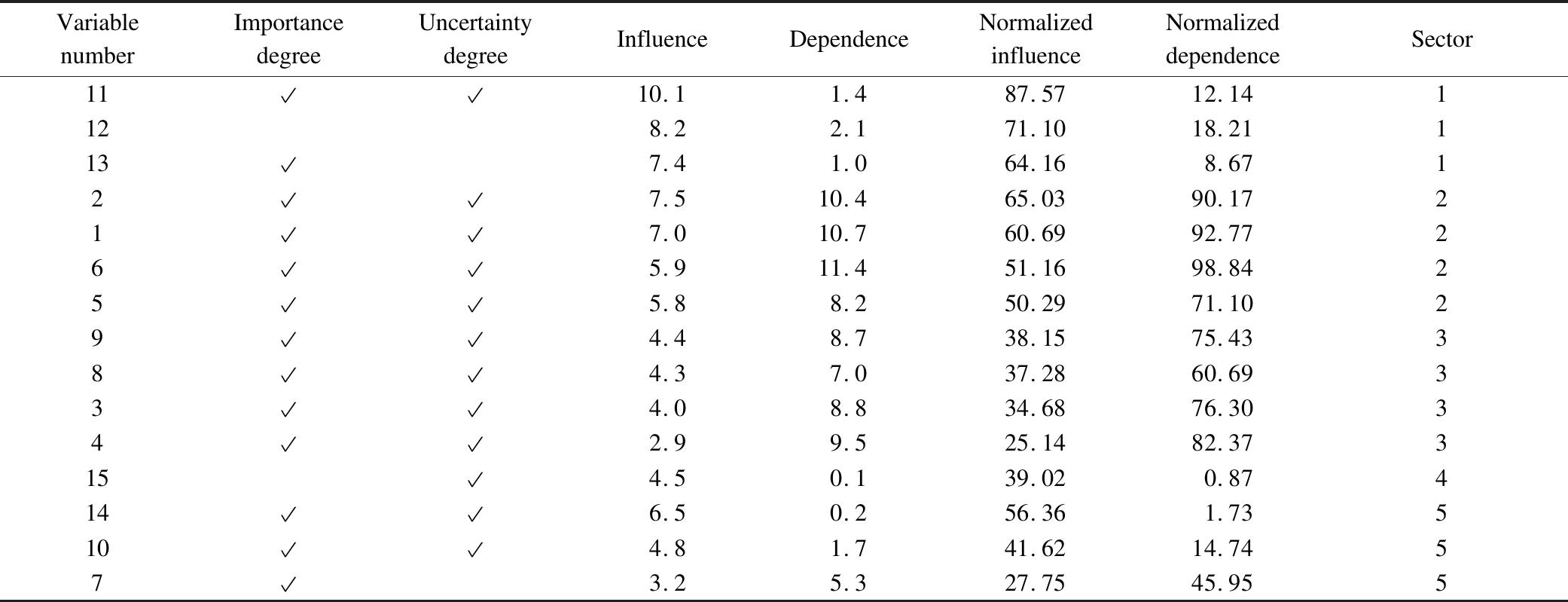
VariablenumberImportancedegreeUncertaintydegreeInfluenceDependenceNormalizedinfluenceNormalizeddependenceSector1110.11.487.5712.141128.22.171.1018.211137.41.064.168.67127.510.465.0390.17217.010.760.6992.77265.911.451.1698.84255.88.250.2971.10294.48.738.1575.43384.37.037.2860.69334.08.834.6876.30342.99.525.1482.373154.50.139.020.874146.50.256.361.735104.81.741.6214.74573.25.327.7545.955

Fig.3 Matrix of influence and dependence
The variables categorized as uncertain can be a basis of scenarios. Variable 11 and variable 14 are selected as the axes. Variable 11 is considered as an axis because it is categorized as uncertain and belongs to sector 1, which corresponds to a key variable of the system. Variable 12 and variable 13 are also part of sector 1, but they are categorized as a trend. Since three variables in sector 1 are identified, with only one categorized as uncertain, variable 14, which is included in sector 5, is selected as another key variable.
There are two reasons that variable 14 is considered as an axis for constructing a scenario, even though it is not included in sector 1. First, the score that excludes ship movement from the category of a key variable is just slightly below the boundary; its influence score is a normalized average of 56.23 points (only 3.77 points below the level are necessary to be classified as a key variable). Secondly, and most significantly, the variable shows very low dependence, and its average normalized dependence score is only 1.73 points. Besides, even though variable 15 shows lower dependence, its influence and importance are lower than variable 14. Thus, variable 14 will be the best choice for sector 5.
2.5 Scenarios generation
As Section 2.4 states, two variables are selected as the key variables, which is the foundation of constructing scenarios. In this step, four scenarios are constructed according to the rules for generating the contrast scenario. Then, different uncertainty variables are combined. Fig.4 describes the synthesis of constructed scenarios. The vertical axis denotes the “ship movement”. The horizontal axis denotes the “workload degree”. According to the interactions between the main variables, four scenarios for the cause of fatigue can be classified into low (third quadrant), medium (second and fourth quadrants), high (first quadrant) levels.
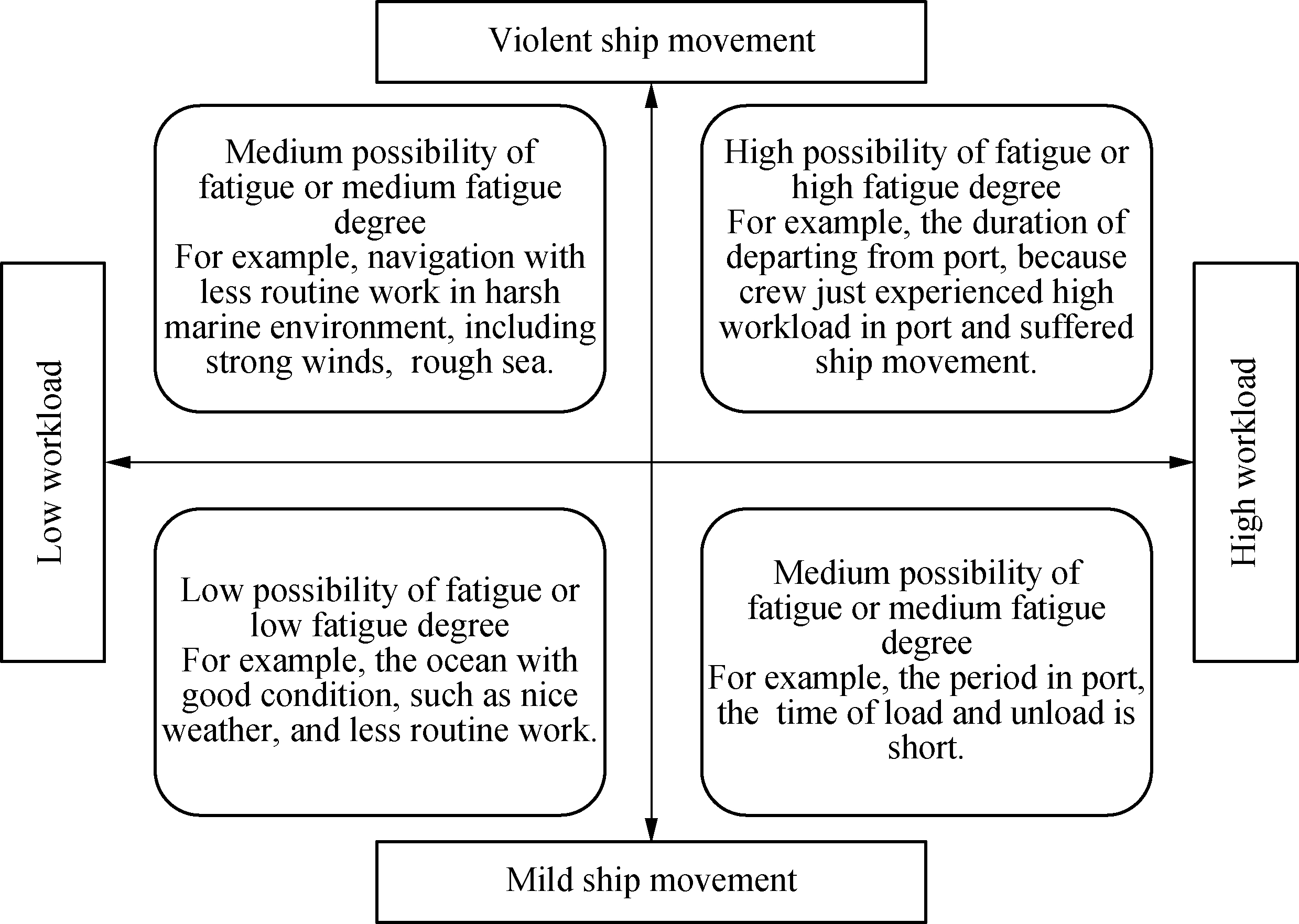
Fig.4 Synthesis of scenarios constructed
The workload and ship movement are two fundamental factors for the scenario description (see Fig.3), and the scenario with the highest fatigue degree is caused by high workload and violent ship movement. The reason of taking this scenario as an example of illustrating the variables relationship is that most circumstances are included. High workload can cause energy consumption increase, stress rise, increased dependence upon drugs, tobacco or alcohol, disrupted sleep patterns or even a disrupted biological clock. The movement of a ship affects the crew’s ability to maintain physical balance. Maintaining balance requires more energy, which can lead to fatigue. The pitching and rolling motion of a ship means that the crew may need to spend 15% to 20% extra effort to maintain balance[6]. In addition, violent ship movements also can impact physical stress, quality of sleep and rest. Compared with the general work on shore, it consumes more energy on board under the same duration. In other words, the crew may work extra time equivalently.
The greater energy consumption may intensify fatigue or lead to a higher probability of fatigue. Additionally, high workloads and violent ship movements can also cause stress and sleeping problems. Fig.5 represents the relationship of some variables. The numbers in the box are the variable numbers. Labels Ⅰ-Ⅳ indicate unfolding variables, including three potential fatigue types (Ⅱ-Ⅳ). Particularly, some of variables are not included, but they are still causes of fatigue. For instance, food or diet can influence sleep patterns because eating large meals before the sleep period may disrupt sleep. For crews with medical conditions and illnesses, even the common cold, these can cause or aggravate fatigue. Boring and repetitive work can also cause fatigue, and also when work is too simple, repetitive and monotonous or physical activity is restricted. Shiftwork and work schedules are supposed to adjust arrangements and reduce fatigue, while inadequate schedules can affect biological clocks and cause fatigue. Noise, vibration, and uncomfortable temperatures or humidity can affect the ability to sleep or rest, and they can affect the level of physical stress, thus causing fatigue[6].
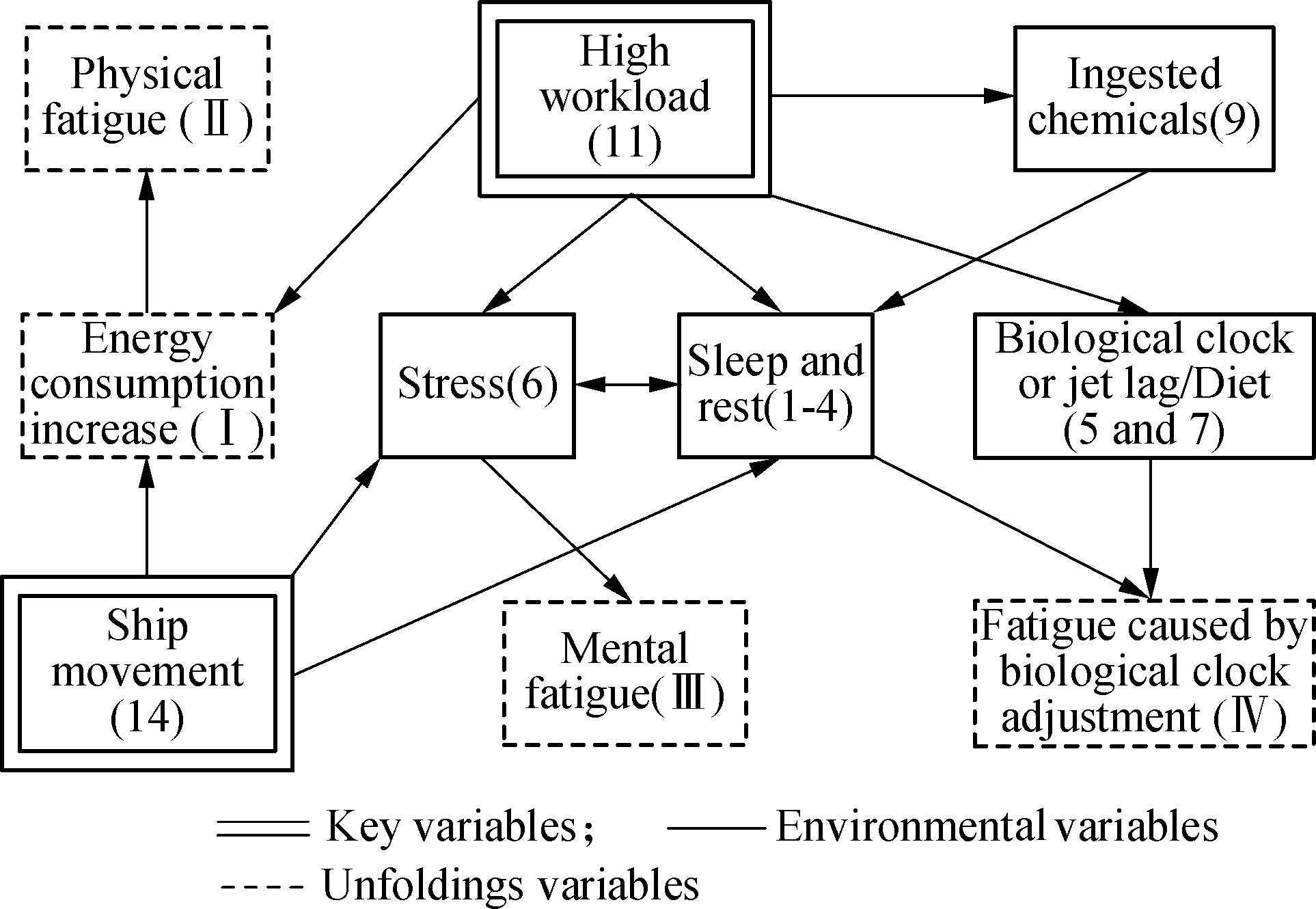
Fig.5 Logical synthesis of a possible scenario
3 Results
According to Section 2, there are several factors that can lead to fatigue. The key variables relate to work and environmental aspect, which can cause others. Moreover, even though variable 12 and variable 13 are considered trends, they are included in sector 1, which means that they are the variables with high influence. If considering the fatigue factors in their classification, the average influence and dependence can indicate a connection of factor classification as well. As Tab.7 shows, the work and environmental factors have a slightly higher influence and remarkable lower dependence, and the average dependence of environmental factors is 3.76. Therefore, it can be assumed that most of crew’s fatigue starts with work and environmental factors, which can be considered as the fundamental reasons of fatigue. These reasons can cause issues in sleep, rest and rhythm, as well as some personal ones, which can interact in the meantime. All of these causes will lead to different types and degrees of fatigue. Therefore, the body function will be weakened by this different fatigue, which includes reaction time, alertness, short-term memory and attention. Consequently, the decreased capabilities can result in some negative effects, including negligence, mistakes, incidences or even accidents. In addition, those effects can be a mutual transformation in some specific circumstances, and they are related to the types and degrees of fatigue, which are relevant to its causes. Fig.6 shows the relationship among different fatigue types.
In Section 2.5, we provide the logical synthesis of a possible scenario, which can be the basis of suggestions to avoid fatigue. Considering the circumstances of maritime transportation, there are several aspects to reduce fatigue, or the probabilities of fatigue, and work environmental factors can be the basic aspects.
Tab.7 Average influence and dependence of variables in classification (in a 100-point scale)

ClassificationDescriptionInfluenceDependenceAverageinfluenceAveragedependenceSleep, restand rhythmLack of sleep60.6992.77Poor quality of sleep65.0390.17Insufficient rest time between work periods34.6876.30Poor quality of rest25.1482.37Biological clock/circadian rhythms/jet lag50.2971.1047.1782.54PersonalconditionPsychological, emotional factors and stress51.1698.84Food/diet (timing, frequency, content and quality)27.7545.95Medical conditions and illnesses37.2860.69Ingested chemicals38.1575.4338.5870.23WorkfactorsBoring and repetitive work41.6214.74Excessive work load87.5712.14Shiftwork and work schedules71.1018.2166.7615.03EnvironmentfactorsNoise or vibration64.168.67Ship movement56.361.73Temperature and humidity39.020.8753.183.76
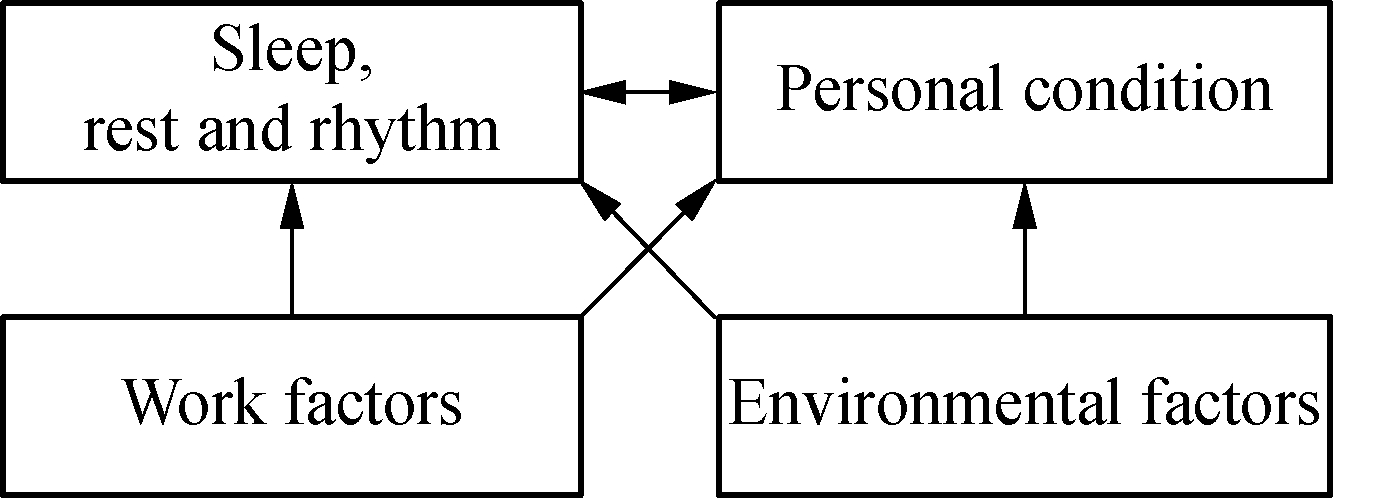 Fig.6 The relationship among fatigue types
Fig.6 The relationship among fatigue types
Before navigation, the vessel, including size, type, or even its engine, can influence work plans, personnel placement, and noise or vibration. In addition, ship route can determine the surrounding water environment, including the weather and waves, which can impact ship movement, or even temperature and humidity. Furthermore, ocean-going voyage, especially across time zones navigation, can cause jet lag and impact human biological clocks or circadian rhythms. These factors are closely connected to sleeping issues. Wearable technology, such as a smart watch or bracelet, can be an effective sleeping monitor tool. Moreover, it can not only provide crew’s sleeping data, but also indicate personal status, such as exercise and diet, which can be the basis of crew assessment.
Once navigation starts, the crew do not change,and their total workload and work type are relatively certain. However, their shiftwork and work schedules can be designed and adjusted. Appropriate and flexible work plans can help the crew to reduce boredom and stress, and they can also contribute to good sleep and rest, and get over the jet lag. Moreover, the crew management including assessment and training is also an important aspect of dealing with personal issues. In particular, personal assessment can reflect the crew’s condition, including their somatic function and mental state, which can also be evidence of sleep quality.
According to Fig.5 and Fig.6, the relationship between the fatigue factors and potential solutions can be illustrated in Fig.7. In conclusion, an appropriate vessel and ship route is related to environmental factors, which are related to solutions before navigation starts. Crew management is related to personal conditions. The monitoring system is a sleep issue, whereas appropriate and flexible work plans are related to work factors.

Fig.7 The relationship between fatigue factors and potential solutions
4 Conclusions
1) This study proposes a structured method with quantitative scales and matrices, which can evaluate the fatigue factors and the relationship between them. Four scenarios have been developed, one of which is selected as an instance to illustrate the development of human fatigue onboard. Thus, a possible scenario of human fatigue in maritime transport can be described, which can present the most general form of crew fatigue.
2) In a complex maritime environment, the scenarios constructed above are capable of revealing fatigue causes and depicting a possible evolutional process. In addition, the construction of fatigue factors can be a foundation of the Bayesian network that illustrates fatigue evolution. This paper does not include this construction because it is difficult to obtain the prior probability of fatigue factors.
3) The combined method is an effective one, which can be extensively applied to various situations including maritime safety. This study indicates two types of contributions: First, the scenario construction of human fatigue in a maritime transportation system illustrates a possible evolution of the crew’s fatigue, which can be an effective tool for studying a maritime safety issue; secondly, the orderly construction of scenarios can provide a foundation and a perspective for studying the related issues in the future.
Acknowledgement
The author thanks to my tutor, Prof. Shi Xin, and Dr. Fu Shanshan, for their professional guidance and patience.
[1]Bal E, Arslan O, Tavacioglu L. Prioritization of the causal factors of fatigue in seafarers and measurement of fatigue with the application of the Lactate test[J].Safety Science, 2015, 72: 46-54. DOI:10.1016/j.ssci.2014.08.003.
[2]Hystad S W, Eid J. Sleep and fatigue among seafarers: The role of environmental stressors, duration at sea and psychological capital[J].Safety and Health at Work, 2016, 7(4): 363-371. DOI:10.1016/j.shaw.2016.05.006.
[3]Hystad S W, Nielsen M B, Eid J. The impact of sleep quality, fatigue and safety climate on the perceptions of accident risk among seafarers[J].European Review of Applied Psychology, 2017, 67(5): 259-267. DOI:10.1016/j.erap.2017.08.003.
[4]Shan D S, Neis B. Employment-related mobility, regulatory weakness and potential fatigue-related safety concerns in short-sea seafaring on Canada’s Great Lakes and St. Lawrence Seaway: Canadian seafarers’ experiences[J].Safety Science, 2020, 121: 165-176. DOI:10.1016/j.ssci.2019.08.017.
[5]Culley K E, Kern D J, Phaneuf M. Are a “can do” attitude and a can of red bull enough? Workload and fatigue in high-stakes, high-demand carrier sortie operations[J].Procedia Manufacturing, 2015, 3: 3062-3069. DOI:10.1016/j.promfg.2015.07.852.
[6]International Maritime Organization. MSC/Circ.1014 Guidance on fatigue mitigation and management [S]. London: International Maritime Organization, 2001.
[7]Smith A, Allen P, Wadsworth E. Seafarer fatigue: The Cardiff research programme [D]. Cardiff, UK: Cardiff University, 2006.
[8]Allen P, Wadsworth E, Smith A. Seafarers’ fatigue: A review of the recent literature[J].International Maritime Health, 2008, 59(1/2/3/4): 81-92.
[9]Rhodes W, Rhodes V G. Fatigue management guide for Canadian marine pilots: A trainer’s handbook [M]. Canada: Marine Safety Directorate and Transportation Development Centre of Transport of Canada, 2002: 5-24.
[10]van Leeuwen W M A, Kircher A, Dahlgren A, et al. Sleep, sleepiness, and neurobehavioral performance while on watch in a simulated 4 hours on/8 hours off maritime watch system[J].Chronobiology International, 2013, 30(9): 1108-1115. DOI:10.3109/07420528.2013.800874.
[11]Strauch B. Investigating fatigue in marine accident investigations[J].Procedia Manufacturing, 2015, 3: 3115-3122. DOI:10.1016/j.promfg.2015.07.859.
[12]Akhtar M J, Bouwer Utne I. Common patterns in aggregated accident analysis charts from human fatigue-related groundings and collisions at sea[J].Maritime Policy & Management, 2015, 42(2): 186-206. DOI:10.1080/03088839.2014.926032.
[13]Bal Be
![]() L, Arslan Ö. The subjective measurement of seafarers’ fatigue levels and mental symptoms[J].Maritime Policy & Management, 2016, 43(3): 329-343. DOI:10.1080/03088839.2015.1047426.
L, Arslan Ö. The subjective measurement of seafarers’ fatigue levels and mental symptoms[J].Maritime Policy & Management, 2016, 43(3): 329-343. DOI:10.1080/03088839.2015.1047426.
[14]Österman C, Hult C, Praetorius G. Occupational safety and health for service crew on passenger ships[J].Safety Science, 2020, 121: 403-413. DOI:10.1016/j.ssci.2019.09.024.
[15]Riethmeister V, Matthews R W, Dawson D, et al. Time-of-day and days-on-shift predict increased fatigue over two-week offshore day-shifts[J].Applied Ergonomics, 2019, 78: 157-163. DOI:10.1016/j.apergo.2019.02.010.
[16]Raele R, Boaventura J M G, Fischmann A A, et al. Scenarios for the second generation ethanol in Brazil[J].Technological Forecasting and Social Change, 2014, 87: 205-223. DOI:10.1016/j.techfore.2013.12.010.
[17]Pereverza K, Pasichnyi O, Lazarevic D, et al. Strategic planning for sustainable heating in cities: A morphological method for scenario development and selection[J].Applied Energy, 2017, 186: 115-125. DOI:10.1016/j.apenergy.2016.07.008.
[18]Postma T, Liebl F. How to improve scenario analysis as a strategic management tool?[J].Technological Forecasting and Social Change, 2005, 72(2): 161-173. DOI:10.1016/s0040-1625(03)00152-5.
[19]Nguyen M T, Dunn M. Some methods for scenario analysis in defence strategic planning [M]. Canberra: Defence Science and Technology Organisation (DSTO), 2009: 1-2.
[20]Kwakkel J H, Auping W L, Pruyt E. Dynamic scenario discovery under deep uncertainty: The future of copper[J].Technological Forecasting and Social Change, 2013, 80(4): 789-800. DOI:10.1016/j.techfore.2012.09.012.
[21]Johansen I. Scenario modelling with morphological analysis[J].Technological Forecasting and Social Change, 2018, 126: 116-125. DOI:10.1016/j.techfore.2017.05.016.
[22]Haydo P A. From morphological analysis to optimizing complex industrial operation scenarios[J].Technological Forecasting and Social Change, 2018, 126: 147-160. DOI:10.1016/j.techfore.2017.06.009.
[23]Lord S, Helfgott A, Vervoort J M. Choosing diverse sets of plausible scenarios in multidimensional exploratory futures techniques[J].Futures, 2016, 77: 11-27. DOI:10.1016/j.futures.2015.12.003.
[24]Penteado Pinto Martins P, Maurício Gama Boaventura J, Americo Fischmann A, et al. Scenarios for the Brazilian road freight transport industry[J].Foresight, 2012, 14(3): 207-224. DOI:10.1108/14636681211239755.
[25]de Brabandere L, Iny A. Scenarios and creativity: Thinking in new boxes[J].Technological Forecasting and Social Change, 2010, 77(9): 1506-1512. DOI:10.1016/j.techfore.2010.07.003.
[26]Mitroff I I, Emshoff J R. On strategic assumption-making: A dialectical approach to policy and planning[J].Academy of Management Review, 1979, 4(1): 1-12. DOI:10.5465/amr.1979.4289165.
[27]Godet M. From anticipation to action [M]. Paris: Unesco Publishing, 1993: 140-153; 161-170; 182-201.
[28]Alreck P L, Settle R B. The survey research handbook [M]. 2nd ed. New York: Irwin Mc Graw-Hill, 1995: 242-267.